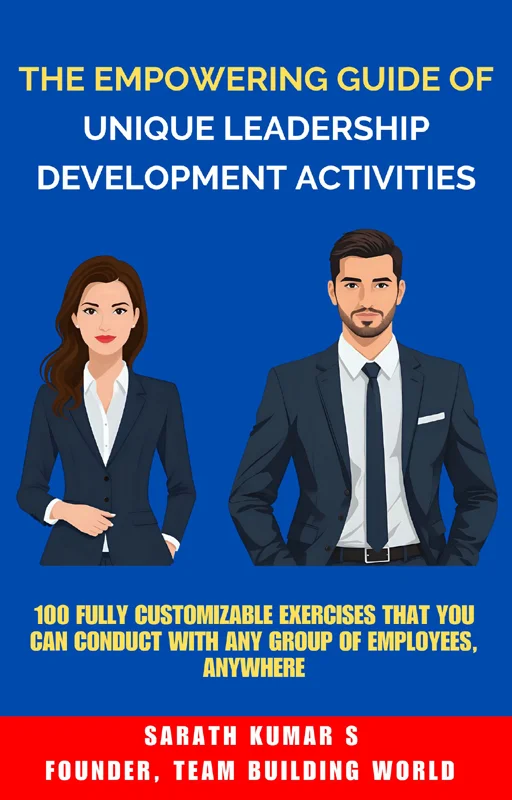10 Negotiation Team Building Activities for the Workplace
Are you in search of some negotiation team building activities for the workplace?
Negotiation skills are essential in any workplace, as they help employees effectively communicate and collaborate to reach mutually beneficial solutions. However, these skills can often be overlooked or underdeveloped in a team setting. That’s where negotiation games come in – they provide an interactive and fun way to strengthen these skills while also promoting teamwork.
In this article, we will discuss 10 negotiation team building activities that you can incorporate into your workplace. These exercises can enhance the leadership skills of your employees.
Why are Negotiation Skills Important in the Workplace?
Before we dive into the activities, it’s essential to understand why negotiation skills are crucial in the workplace. Negotiation involves finding a mutually beneficial outcome between two parties with conflicting interests. In a work setting, this could mean resolving conflicts between team members, negotiating contracts or deals with clients, or even negotiating for a raise or promotion.
Strong negotiation skills can lead to improved collaboration among team members, increased productivity, and better problem-solving abilities. It also fosters a positive work culture where employees feel heard and valued.
10 Negotiation Team Building Activities for the Workplace
Here are some negotiation team building exercises that you can implement in your workplace.
#1. Role-Playing Negotiation
This activity allows employees to step into different roles and practice their communication, listening, and problem-solving skills. It is a classic and effective way to practice negotiation skills.
Time: 10-20 minutes
Materials: None
Participants: 2-6 people per group
Instructions
- Divide the participants into pairs or small groups.
- Provide each group with a workplace scenario that requires negotiation, such as deciding on a budget allocation or resolving a conflict.
- Ask each team to discuss and negotiate the scenario, taking on different roles and aiming for a win-win outcome.
- After the negotiation, allow participants to share their experiences and insights.
Debrief
Discuss the importance of effective communication, active listening, and collaboration in successful negotiations. Encourage the participants to reflect on strategies that worked well and areas for improvement in their negotiation process.
You can also read: 10 Leadership Communication Activities (With Debrief)
#2. Build a Bargain
This creative activity encourages teamwork and effective negotiating by involving participants in a simulated bargain-building exercise.
Time: You decide
Materials: Assorted items or office supplies
Participants: Teams of 3-6 people
Instructions
- Provide each team with a random set of items (e.g., pens, paper clips, sticky notes, etc.).
- Assign every team a specific goal, such as building a functioning object or solving a problem using their items.
- Teams must negotiate with other groups to trade items and complete their task.
- Monitor the negotiations and ensure fairness throughout the activity.
Debrief
At the end of the exercise, have teams present their final product. Discuss the negotiation strategies they used to secure what they needed and how they overcame challenges. Highlight the importance of persuasion, compromise, and innovative thinking.
You can also read: 10 Sales Team Building Activities for the Workplace
#3. The Auction Challenge
This fast-paced activity fosters strategic thinking and highlights the importance of preparation in negotiations.
Time: 15-20 minutes
Materials: Fake currency or tokens, and auction items (can be written on cards or physical objects)
Participants: 3-6 people in a group
Instructions
- Distribute a set amount of fake currency or tokens to each group.
- Present a list of “auction items” tied to workplace scenarios (e.g., extra resources, time off, priority scheduling, etc.).
- Teams must plan and strategize how to bid effectively during the auction while staying within the budget.
- Conduct the auction, and encourage competitive but respectful interactions.
Debrief
Afterward, discuss how planning, teamwork, and decision-making influenced the outcomes. Encourage the participants to reflect on the importance of understanding value and prioritizing group goals over individual desires in negotiations.
You can also read: 10 Difficult Conversations Group Exercises (With Debrief)
#4. Trading Floor Simulation
This dynamic activity immerses participants in a high-energy trading environment, encouraging quick thinking and collaboration under pressure.
Time: You decide
Materials: Fake commodities, price sheets, and scorecards
Participants: Teams of 2-8 people
Instructions
- Provide each team with a set of fake commodities (e.g., paper cards labeled with resources like “gold,” “oil,” “electronics”).
- Assign fluctuating values to each commodity, updating the prices every few minutes.
- Teams must negotiate trades with other groups to maximize the value of their portfolio by the end of the simulation.
- Keep track of transactions and provide updates on market conditions to increase tension and excitement.
Debrief
Review the strategies participants used to adapt to changing prices and market conditions. Discuss how flexibility, quick decision-making, and interpersonal skills were critical to their success. Highlight the importance of adaptability and seizing opportunities during negotiations.
#5. The Negotiation Maze
This activity requires teams to collaborate and make collective decisions while navigating their way through a metaphorical maze.
Time: 15-20 minutes
Materials: Pre-designed maze task on paper or slides, and optional props for physical activity
Participants: Teams of 4-8 people
Instructions
- Present the teams with a maze scenario that includes various checkpoints requiring decisions, such as choosing between different paths or solving challenges to move forward.
- Each decision involves negotiation within the team or with other groups to determine the path forward.
- Teams must reach the end of the maze within the allotted time while reflecting on their decision-making strategies.
Debrief
Discuss how the participants worked collaboratively to prioritize goals and make compromises. Explore how negotiation and consensus-building played a role in overcoming obstacles and achieving success. Highlight the importance of aligning team goals with individual contributions.
#6. Resource Allocation Challenge
This engaging activity emphasizes the importance of balancing priorities and resources during negotiations.
Time: You decide
Materials: Resource cards or tokens, and a list of workplace tasks or project scenarios
Participants: 3-8 individuals in a group
Instructions
- Assign each group a scenario where they need to allocate limited resources (e.g., money, time, personnel, etc.) to complete a set of tasks.
- Teams must negotiate internally and with other groups to acquire or share resources needed for their goals.
- Encourage creative solutions and collaboration throughout the process.
Debrief
After the challenge, have each team present their chosen strategy and outcomes. Discuss the importance of clear communication, persuasion, and compromise in achieving optimal results. Reflect on how understanding priorities and limits is crucial during real-world negotiations.
#7. The Win-Win Puzzle
This activity focuses on the concept of creating mutually beneficial outcomes and emphasizes the power of collaboration.
Time: 10-20 minutes
Materials: Puzzle pieces or task components that are divided between teams
Participants: Teams of 3-6 people
Instructions
- Divide the puzzle pieces or components among the teams, ensuring no single group has enough to complete the task alone.
- Ask the teams to negotiate and collaborate with others to gather the necessary pieces or resources.
- Encourage creative problem-solving and open communication to achieve a solution that benefits all sides.
Debrief
Once the puzzle is completed, discuss how the teams identified shared goals and worked towards a win-win outcome. Highlight the importance of cooperation, trust, and clear communication in reaching agreements that satisfy everyone’s needs.
#8. The Collaborative Contract
This task emphasizes the process of building consensus and developing agreements that satisfy all parties involved.
Time: You decide
Materials: Simple contract templates, scenario descriptions, paper, and pens
Participants: 3-8 individuals in a team
Instructions
- Present a scenario requiring participants to draft a collaborative agreement, such as dividing project responsibilities or resolving a shared conflict.
- Provide a contract template where participants can outline the terms, responsibilities, and benefits for each stakeholder involved.
- Encourage the participants to focus on fairness and mutual benefit while negotiating the terms of the contract.
- Once completed, have each group present their finalized contract to the room for discussion.
Debrief
Analyze the negotiation process behind drafting the contracts. Discuss what worked well, the challenges faced, and how compromise or innovative solutions were achieved.
#9. Time Crunch Negotiation
This fast-paced activity simulates the pressure of high-stakes negotiations with a strict time limit.
Time: 15-20 minutes
Materials: Negotiation scenarios, a timer, and optional tokens or props
Participants: 2-8 people per team
Instructions
- Present the team members with a high-pressure negotiation scenario where they must quickly agree on terms to achieve their goals.
- Set a strict time limit for the negotiation process, ensuring rapid decision-making and execution.
- Encourage the team members to stay composed and focus on persuasive communication despite the time constraint.
Debrief
Explore the challenges of maintaining clear communication under stress and the importance of prioritizing key objectives. Reflect on how mastering time-sensitive negotiations can lead to better outcomes in real-world scenarios.
#10. The Ultimate Challenge
This final activity combines all the previous tasks and challenges participants to apply their negotiation skills in a competitive setting.
Time: You decide
Materials: Negotiation scenarios, props or tokens, a timer, and scorecards for each team
Participants: Teams of 4-8 people
Instructions
- Assign the teams different negotiation scenarios with varying levels of complexity and stakes.
- Each team must complete multiple negotiations within a set time limit while keeping track of their overall score.
- Encourage them to strategize, collaborate, and leverage their strengths throughout the challenge.
Debrief
After the challenge, discuss each team’s strategies and outcomes. Highlight the importance of preparation, teamwork, communication, and adaptability in achieving optimal results in negotiations.
Want Some Unique Leadership Development Activities?
If you want some unique activities to equip your employees with leadership skills, qualities, and mindset, you can get my new e-book:
Or Want Some Unique Team Building Activities?
If you want some unique activities for your employees (both in-person and virtual), you can get my new e-book:
Final Words
By incorporating these activities into your workplace, you can cultivate a collaborative and skilled team that excels in negotiations. Remember, the key is to create a supportive environment where employees can learn from each other and experiment with different approaches. With consistent practice, your team will become confident negotiators who build successful relationships with clients, colleagues, and stakeholders.
FAQ: Negotiation Team Building Activities
You might have these questions in mind.
What is the main purpose of these negotiation activities?
The primary goal of these activities is to build essential negotiation skills such as communication, collaboration, problem-solving, and adaptability. By engaging in these exercises, participants gain practical experience and confidence, which helps them handle real-world negotiation scenarios effectively.
Can these activities be adapted for virtual teams?
Absolutely! Many of these activities can be modified to fit virtual settings using tools like video conferencing, collaborative documents, or online whiteboards. Adjustments such as sharing resources digitally or using breakout rooms for group discussions can make the experiences just as effective online.
What if my team is unfamiliar with negotiation concepts?
These activities are designed to be accessible to participants at all skill levels. To ensure success, you can start each session with a quick overview of basic negotiation techniques and principles. Providing clear instructions and guidance will also help participants feel comfortable engaging in the tasks.
How can I measure the effectiveness of these activities?
Effectiveness can be evaluated through both qualitative and quantitative means. Observing participants’ collaboration, creativity, and problem-solving during the exercises is key. You can also gather feedback from employees afterward and track improvements in negotiation performance in workplace scenarios over time.
Can these activities strengthen team relationships?
Yes! Negotiation exercises often encourage open communication, trust-building, and empathy, which naturally foster stronger connections among team members. Working together to achieve common goals underpins teamwork and creates a more cohesive environment.

